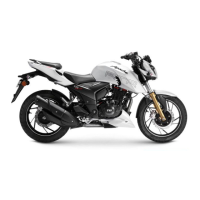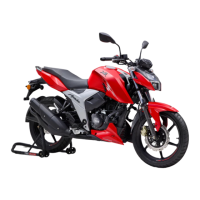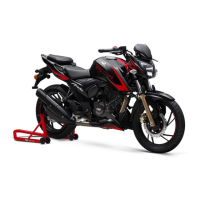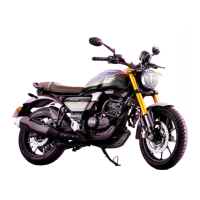7
7
Anti-Lock Brake System (ABS)
Your vehicle is equipped with RTLSC or RTDSC as per your choice of vehicle configuration. These are advanced ABS
technologies that improve your ownership experience. Anti-lock braking system (ABS) is designed to prevent skidding
& help riders to maintain steering control during emergency-stopping situation in dry or wet roads, loose gravels etc.
How does ABS work?
When a rider applies the brakes continuously as he detects a dangerous obstacle in dry or wet roads, loose gravels
etc. thus transmitting excessive brake force to the wheel. This excessive force may cause the wheel to stop spinning
and leads to loss of grip. With no firm contact between the tire’s contact patch and the road surface, the bike
becomes unstable and a crash is imminent.
The slipping wheels on a riding surface results in losing control of whole motorcycle which usually occurs in fraction
of a second. Restoring traction while keeping the bike balanced is only a result of luck, or extreme training, as is
the case of professional stunt riders who drift. Preventing the wheels from slipping due to excessive braking force
compensates losing control and help the rider to maneuver the vehicle and to avoid accidents.
So what the ABS does is actually limiting the braking force exerted by the rider by regulating the brake pressure
and keep the wheel spinning. Once the imminence of the locking (and therefore skidding) is avoided, the system
re-applies the maximum braking force until the next skid is anticipated. By limiting the max force of the braking
maneuver, the ABS systems practically allow riders to use the greatest stopping force possible without locking the
wheels.
How does the ABS understands the wheel locking?
The ABS uses continuous wheel speed monitoring system; wheel speed sensors and toner rings (pulsar rings) and a
Hydraulic Electronic Control Unit (HECU).
During normal operation the ABS works similar to a normal brake, but functions only when the wheel tends to lock
up. The speed sensors fitted on both the wheels measures the rotational speed of the wheel, when the wheel speed
reduces rapidly i.e. wheel tends to lock, the HECU modulates the pressure in the brake circuit and thereby prevents
the wheel from locking.
KNOW YOUR MOTORCYCLE

